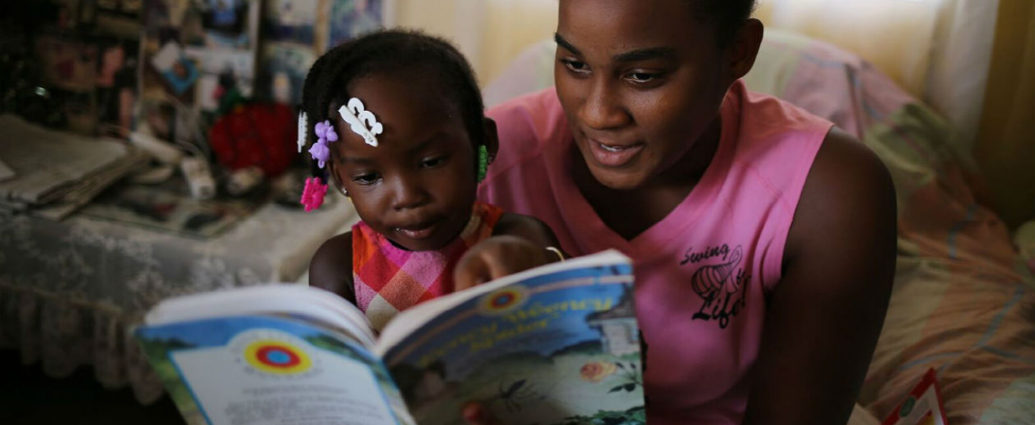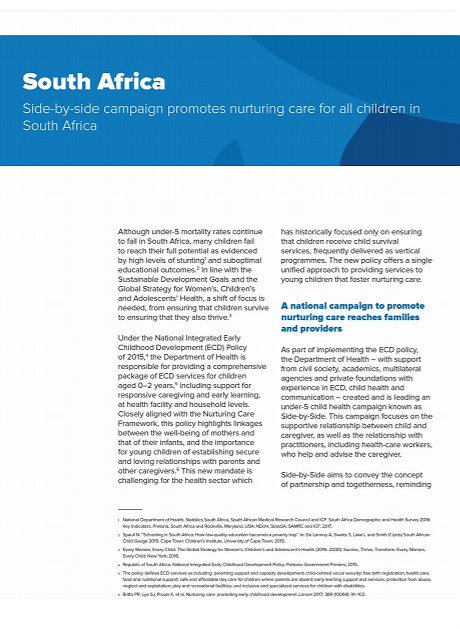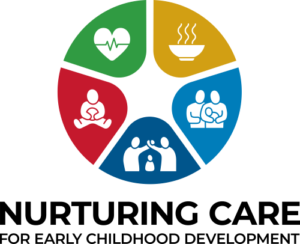Although under-5 mortality rates continue to fall in South Africa, many children fail to reach their full potential as evidenced by high levels of stunting1 and suboptimal educational outcomes2. In line with the Sustainable Development Goals and the Global Strategy for Women’s, Children’s and Adolescents’ Health, a shift of focus is needed, from ensuring that children survive to ensuring that they also thrive3.
Under the National Integrated Early Childhood Development (ECD) Policy of 20154, the Department of Health is responsible for providing a comprehensive package of ECD services for children aged 0-2 years5, including support for responsive caregiving and early learning, at health facility and household levels.
Closely aligned with the Nurturing Care Framework, this policy highlights linkages between the well-being of mothers and that of their infants, and the importance for young children of establishing secure and loving relationships with parents and other caregivers6. This new mandate is challenging for the health sector, which has historically focused only on ensuring that children receive child survival services, frequently delivered as vertical programmes. The new policy offers a single unified approach to providing services to young children that foster nurturing care.
A national campaign to promote nurturing care reaches families and providers
As part of implementing the ECD policy, the Department of Health — with support from civil society, academics, multilateral agencies and private foundations with experience in ECD, child health and communication — created and is leading an under-5 child health campaign known as Side-by-Side. This campaign focuses on the supportive relationship between child and caregiver, as well as the relationship with practitioners, including health-care workers, who help and advise the caregiver.
Side-by-Side aims to convey the concept of partnership and togetherness, reminding everyone that “it takes a village to raise a child”. It presents the idea of child rearing as a journey shared by caregivers, their children and all those who help and support them.
The campaign speaks to caregivers: its central message is “You are central to your child’s nurturing, care, and protection — and their lifelong health outcomes. Your health worker is there to support you.”
At the centre of a campaign is the Road to Health booklet (RtHB), which has been redesigned and revised by the Child, Youth and School Health directorate within the National Department of Health. All parents receive the booklet on the birth of each child; it serves as a health record as well as containing health and development promotion messages. The RtHB has been revised to make it more user-friendly and to maximize its potential as a tool for communication and behavioural change. Its content is organized around five “knowledge pillars” or themes: nutrition, love, protection, health care and extra care (Figure 1).
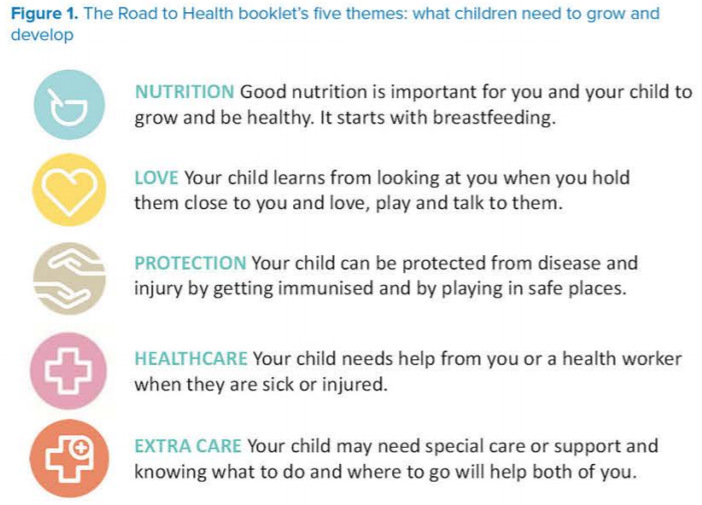
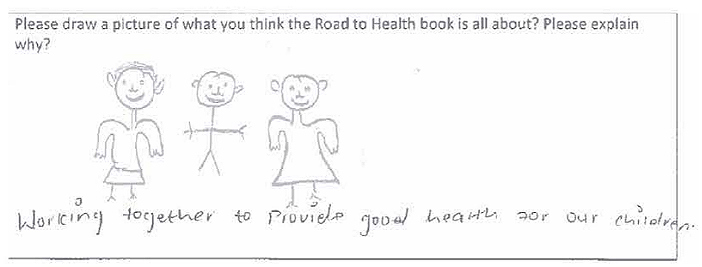
These pillars address the needs of children (as opposed to the services delivered by the health system) and are intended to cover all aspects of early childhood growth, health and development. Each section of the RtHB includes messages for caregivers and a log to be completed by health-care workers recording the child’s growth and development.
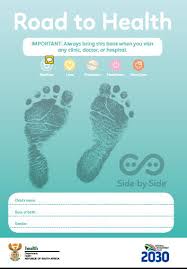
In addition to the revised RtHB and accompanying materials, the Side-by-Side campaign includes:
• A radio drama to be broadcast weekly on 11 regional radio stations in 9 of the country’s 11 official languages. It will cover topics related to all five pillars; each episode will be followed by a question and answer session featuring a local health-care worker or other early childhood development expert, and it will run from June 2018 for three years;
• MomConnect: a mobile phone service through which pregnant women and mothers of children aged 0-1 receive regular texts. Messages for mothers of children up to age 5 are currently being developed, and will be provided to caregivers through a Side-by-Side app; and
• provision of printed materials including Side-by-Side messages in all official languages.
| | also liked the information where it talks about the importance of both parents taking part in the development of the baby. It's not the responsibility of a mom only to take care of the child but the dad also has a part to play: children need their fathers as well to be happy. Community health worker, focus group discussion, KwaZulu-Natal |
|---|
Challenges and lessons learned
Ensuring optimal use of the RtHB remains an important challenge. Although some of the interventions outlined in the booklet are already provided at scale (e.g. immunization), others (e.g. tracking of developmental milestones) are less widely provided. Including these intervention in the RtHB and popularizing the five pillars should promote demand for the services. In the medium term, it is anticipated that health- care workers at primary level facilities and community health workers during household visits will address each of the five pillars in every child health consultation. Addressing both demand and supply sides should facilitate scale-up of these interventions.
The road ahead
One million RtHBs have been printed and distributed to South Africa’s nine provinces; health-care workers in all 52 districts have been informed about it; and each province has a plan to ensure optimal use of the booklet.
Other plans for 2018 include promoting Side-by-Side community activities, at which information and early childhood services (from the health and other sectors) will be provided, and developing protocols and tools to ensure that child health visits are structured around the booklet’s five themes.
While the packages of care associated with the nutrition, protection and health care pillars are relatively well defined, further work is required to develop the pillars of love and extra care. Further work on monitoring and evaluation is also required. A draft ECD dashboard has been developed, and opportunities are being explored for using this to provide feedback to health workers and other officials at provincial and district levels.
The Side-by-Side campaign has been well received by many stakeholders. It is hoped that over the next three to five years it will provide a platform for introducing the concept of nurturing care, and expanding and strengthening the package of services provided to young children in South Africa.
| This book is not only for immunization like the other one, it will help me to see if my baby is growing well. There is so much information for mothers. Caregiver, focus group discussion, Limpopo |
|---|
For more information, please contact NurturingCare@who.int
Endnotes
1 National Department of Health, Statistics South Africa, South African Medical Research Council and ICF. South Africa Demographic and Health Survey 2016: Key Indicators. Pretoria, South Africa and Rockville, Maryland, USA: NDoH, StatsSA, SAMRC and ICF; 2017.
2 Spaull N. “Schooling in South Africa: How low-quality education becomes a poverty trap”. In: De Lannoy A, Swartz S, Lake L and Smith C (eds) South African Child Gauge 2015. Cape Town: Children’s Institute, University of Cape Town; 2015.
3 Every Women, Every Child. The Global Strategy for Women’s, Children’s and Adolescent’s Health (2016-2030): Survive, Thrive, Transform. Every Women, Every Child: New York; 2016.
4 Republic of South Africa. National Integrated Early Childhood Development Policy. Pretoria: Government Printers; 2015.
5 The policy defines ECD services as including: parenting support and capacity development; child-centred social security; free birth registration; health care; food and nutritional support; safe and affordable day care for children where parents are absent; early learning support and services; protection from abuse, neglect and exploitation; play and recreational facilities; and inclusive and specialized services for children with disabilities.
6 Britto PR, Lye SJ, Proulx K,et al. Nurturing care: promoting early childhood development. Lancet 2017; 389 (10064): 91-102.
This profile was developed in support of Nurturing Care for Early Childhood Development. A framework for helping children to survive and thrive to transform health and human potential.
Writer: Katelin Gray, PATH USA. Contributors to development and review: Matthew Frey, Bettina Schwethelm. Design: PATH.




